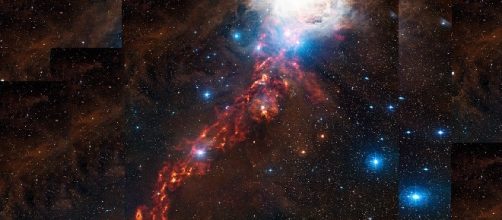Protostars and pre-main sequence stars
The Orion Nebula provides astronomers with new insights into star formation. The proposal is contained in maps that show the distribution of gas and dust formation known as the integral–shaped filament in the Orion Nebula Cluster.
The proof for this hypothesis is given by the way in which protostars and other stars in the process of formation are positioned in the locations near the filament. Protostars (stars in the earliest stage of formation) are small enough to be carried along with the filament when it undulates, while young stars, which have accrued more dust and gas, are not.
Interaction of gravity and magnetic field
While it is known that gravity can produce filamentary structures, a different force is needed to originate the filamentary undulation. The discovery in 1997 by Heiles, that the Orion filament is surrounded in a helical magnetic field, confirmed the nature of these filaments, which display magnetic field lines fluctuating as they move across the filament.
How a star is created
In a graphical demonstration of the star formation process, it´s shown that the core of a star begins to form in the filament, eventually evolving into a protostar which is dragged by the moving filament. The protostar accrues more mass but remains in synchronicity with the rate of the filament’s acceleration.
When the filament reaches maximum acceleration, the protostar´s inertia pulls it out from the filament and the star ends up out of the filament.
This picture demonstrates a process for the formation of star clusters in a relatively short time scale. The positions of star clusters in and out of the filament show the way in which the filament might have been stretched, and how, over millions of years, one cluster of stars got formed sequentially, diffusing gas and dust in the immediate space in the process.
In the present, this is only a proposed mechanism for star cluster formation. Further studies and observations will confirm whether clusters of stars, formed in gravitating and magnetically glowing filaments, is the universal mechanism for creating stars.

